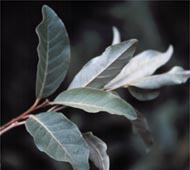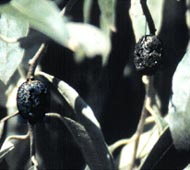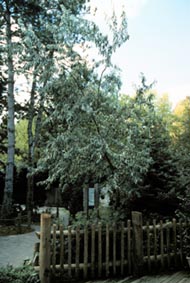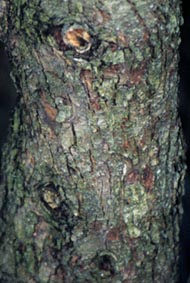Russian Olive (Oleaster)

Leaf Characteristics
- broad, flat leaves
- simple leaves
- not lobed
- smooth margins, entire
- alternate leaves
- without needle-like bristles
- not heart-shaped
- widest toward tip or middle
- 1 - 5 inches long with silver scales

Fruit Characteristics
- other fruit (not cone, winged, acorn, or in pod or capsule)
- without husk or capsules
- loose, not packed tightly together
- fruit with pit
- whole fruit less than 1 inch
- fruit without strap-like modified leaf
- not like rasperries
- fruit not at end of single stalk
- loosely clustered
- leaves not modified
- ovoid, with silver scales, about 1/2" long
- fruit not at ends of club-shaped stalks
Russian Olive (Oleaster)
Elaeagnus angustifolia
The Russian Olive is a native of southern Europe, and western and central Asia. It was introduced into North America during early colonial times. The trunk typically is crooked. The thin bark is brown, fissured, and it shreds off in long strips. This is a hardy and vigorous tree and it grows easily in many kinds of soils. Its tolerance of salt makes this a very useful tree along mid-western highways where de-icing salt damages many trees. Landscapers like the Russian Olive for its unusual combination of gray foliage, silver-white flowers, and silver-scaled fruit, which eventually turn reddish.
 Tree Size
height 10' - 20'
diameter about 4"
Tree Size
height 10' - 20'
diameter about 4"
 Bark
Bark 